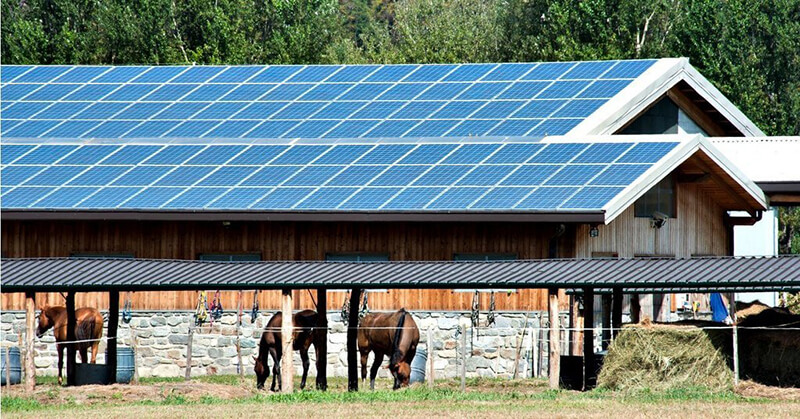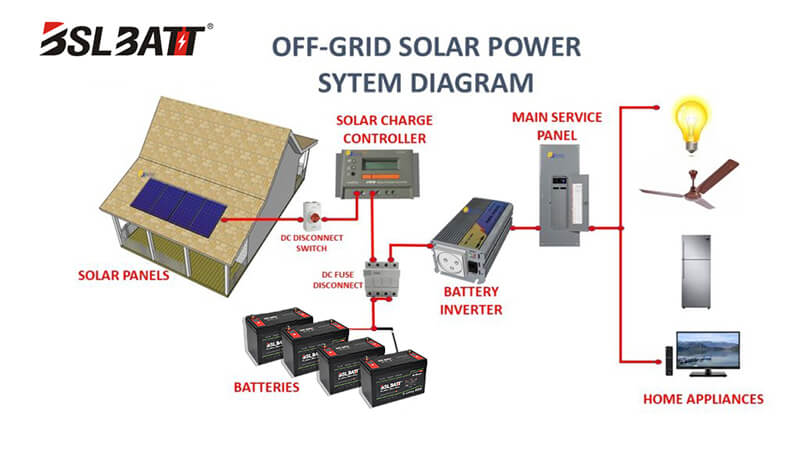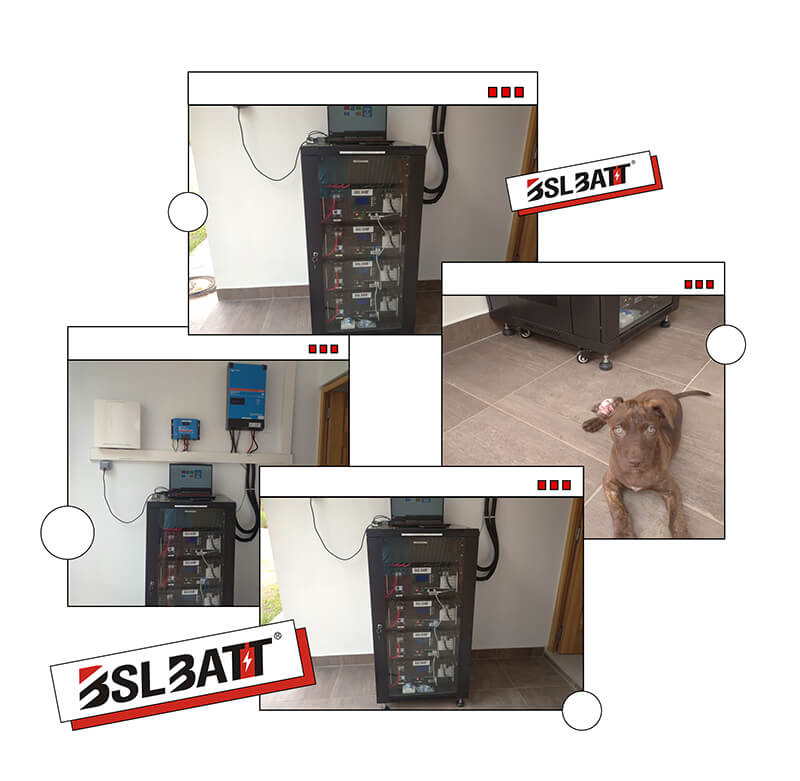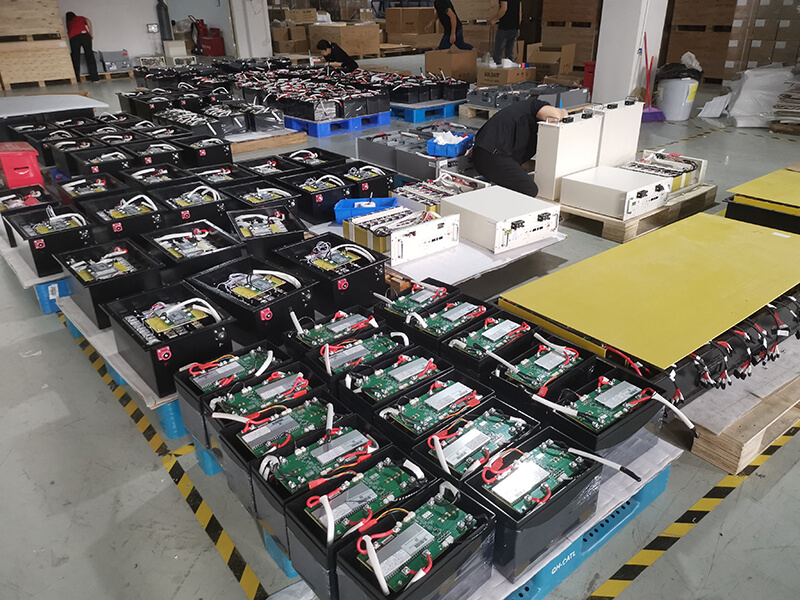Industry Application
Product Type
How to Build an Off-Grid Solar System in Just 6 Steps
| Solar Energy System for Off-Grid Living
There are many different kinds of solar power systems including grid-tied, hybrid, and off-grid solar power. Out of the three main options for solar, off-grid solar power is by far the most independent of systems. Installing an off-grid solar system was once a fringe concept due to its large space requirements and prohibitive costs. But advances in solar tech over the last decade have made solar equipment more efficient and less expensive, helping to push them into the mainstream. It’s now a fairly common sight to see RVs and country cabins powered entirely by off-grid solar systems. Fortunately, we have you covered when it comes to designing your off-grid power system from scratch, including determining your energy needs, solar and battery system sizing and the additional components you will need. Take a look below to learn the six steps you can take to power up your self-sufficient lifestyle today.
What is an Off-Grid Solar System? An off-grid solar system is a stand-alone electrical power system that uses solar energy as its resource. ● An off-grid solar system is not connected to the main public utilities (especially the electricity grid). ● It generates DC electricity from solar panels and stores it by utilizing batteries. ● It powers the home appliances by converting the stored DC electricity into AC using an off-grid inverter. Furthermore, we will give you a simple explanation of what an off-grid solar power system is. Some articles and books talk about this topic but, they can be confusing sometimes. The main goal is to give you a strong start for your DIY off-grid solar system project. Typical Off-Grid Solar System Diagrams Here, you will see a couple of wiring diagrams for a typical off-grid solar system. A wiring diagram, by the way, is a simple depiction of how each component of a system is connected. Typically, an off-grid solar power system includes solar modules, DC cables, a battery, a charge controller, and a battery inverter.
Detailed below are 6 steps to get you moving towards off-grid solar living. Step #1: Determine how much energy and maximum power you will need Although many people often skip over this step and move straight to purchasing their off-grid solar-plus-storage system, this is one of the most important steps you can take to ensure you don’t waste your money on an oversized system or end up with a system that isn’t able to sufficiently meet your energy needs. In order to correctly determine your energy needs, you will need to use a loan calculator or work directly with a representative from BSLBATT. Enter each appliance or item you will be powering with your energy system, how often you use it per day, as well as the item’s relevant specifications. Try your best to remember every item you will be using with your power system, as seemingly small edits to your load calculation can end up making a large impact. If you would prefer to make this calculation manually on your own, note that every electronic device will indicate the electrical load it draws on its label or packaging. Knowing the individual power requirement of your appliances or equipment is essential in this stage. It is helpful if you list down all your devices with their corresponding power requirements in Watts. You may usually see this on their information nameplates. This is a crucial step to do so that you will not fall short or oversize your off-grid solar system capacity. Before choosing the components, you have to calculate your power consumption. How long are you planning to run your appliances in hours? What is the individual load requirement of your devices in Watts? To calculate the power consumption in Watt-hours, simply answer the questions and multiply each load (Watts) by the time (hours) they need to be running. Once you have targeted the loads, calculate the energy rating for each load as follows: Note the power rating specified on the loads (devices connected such as TV, fans, etc) in Watts Note the running time of each load in hours Calculate the energy consumption as per the below formula(consider approximately 25% as energy loss factor) Energy(watt-hour)= Power(Watt) x Duration(hours) Summation of daily consumed energy by all the loads Note down all the target appliance ratings and energy consumption as described below:
One can also check for the previous electricity bills and can consider the highest of all as the energy consumption required for the design of a solar energy system. By following the above steps for all the AC loads we have calculated: Power = 380 watts Calculated Energy = 2170 watt-hour Total Energy(add 25% as energy loss factor) = 2170 *1.25 =2712.5 W-h Will design the solar energy system by keeping in mind the above ratings. Step #2: Determine the number of batteries you will need After you have determined how much energy and maximum current or power you need, you will need to figure out how many batteries you need to properly store all of that energy as well as meet your power and current needs. During this process, make sure to ask yourself questions like whether you only need enough storage for a day or two, or if you need to have enough storage for three or more days; whether you will incorporate another power source, such as a wind turbine or generator, to use during consecutive cloudy days; and whether you will be storing the batteries in a warm room or a cold location. Batteries are often rated for storage at higher temperatures because, in colder temperatures, the battery’s ability to provide sufficient power is diminished. Therefore, the colder the room, the larger the battery bank you need. For example, in below-freezing temperatures, you may need over 50 percent more battery capacity. Note that there are few battery companies that do offer a battery that is designed specifically for below-freezing temperatures though. Factors such as those listed above all affect the size, and cost, of your battery bank. An additional factor to consider is that lead-acid batteries can only be discharged up to 50 percent without being damaged, unlike lithium batteries – especially lithium iron phosphate batteries, which can be safely discharged up to 100 percent. For this reason, lithium batteries are an ideal choice for off-grid power systems, which often require the ability to discharge more deeply. You would also have to buy twice as many lead-acid batteries compared to lithium batteries just to reach the same usable capacity, after the depth of discharge, charge rates, and efficiency rates are factored in. After taking into account these considerations, you will then need to determine what voltage battery bank you need, ranging from 12V to 24V to 48V. In general, the larger the power system, the more likely you are to need a higher voltage battery bank in order to keep the number of parallel strings to a minimum and reduce the amount of current between the inverter and the battery bank. If you just have a small system and want to be able to charge minor items like your tablet and power 12V DC appliances in your RV, then a basic 12V battery bank is suitable. However, if you need to power well over 2,000 watts at a time, you’ll want to consider 24V and 48V systems instead. In addition to reducing how many parallel strings of batteries you will have, this will allow you to use thinner and less expensive copper cabling between the inverter and the batteries. Let’s say you decide a 12V battery bank is best for your needs and that you came up with daily use of 500Ah in step #1. Looking at BSLBATT’s 12V batteries, you would have several options. For example, you could use five of the BSLBATT 12V 100Ah B-LFP12-100 batteries, or two of the BSLBATT 12V 300Ah B-LFP12-300 batteries. Of course, if you are unsure as to which BSLBATT battery is best for your needs, please contact us and we will work with you to find the right size bank of the right batteries to keep you powered up.
Step #3: Sizing of Inverter Once we have estimated the energy requirement, the next task is to calculate the inverter rating for the same. Inverter selection plays an important part in our solar energy design, as it is responsible for converting the direct current generated from the solar panel into alternating current(as the loads connected at our home mostly run on AC supply) as well performing other protection measures. Consider an inverter with fair efficiency, we have considered an inverter with 85% efficiency The total power wattage consumed by the loads is considered as an output of the inverter (i.e. 380W) Will add 25% as a safety factor in the required power wattage. 380 * 0.25= 95 Total power wattage required = 380+95= 475 W Calculate the inverter input capacity rating Input(VA) = Output(watt) / efficiency X 100 = 475(watt) / 85 X 100 = 559 VA = 560VA The required input power for the inverter is estimated as 559 VA, now we need to estimate the energy input required by the inverter. Input Energy(Watt-hour) = Output (watt-hout) / Efficiency x 100 = 2712.585 X 100 = 3191.1 Watt-hour Now, once we have determined the inverter capacity, the next task is to check the inverter available in the market. The typical inverter available comes with 12V, 24V, 48V system voltage. As per our estimated energy rating of 560VA, we can select a 1 kW system inverter. Generally, a 1 kW inverter has a 24V system voltage. (Generally 1kW and 2kW – 24V, 3kW to 5kW – 48V, 6kW to 10 kW – 120V) It is always necessary to see the inverter specification datasheet to determine the system voltage. Our BSLBATT Battery has matched many inverter brands. We have everything you want! Right now, please Step #4: Determine the number of solar panels you will need The four-part of your off-grid power system calculation involves determining how many solar panels you will need. After you know how much energy you need to produce per day from your load calculations, you need to factor in how much sunlight will be available for you to harvest from, otherwise known as “sun hours.” The number of “sun hours” is determined by how many hours the available sun in a given location shines on your panels at a specified angle throughout the day. Of course, the sun isn’t as bright at 8 a.m. as it is at 1 p.m., so an hour of morning sun may be counted as half an hour, whereas the hour from noon to 1 p.m. would be counted as a full hour. Also, unless you live near the equator, you do not have the same number of hours of sunlight in the winter as you do in the summer. It’s also recommended that you base your solar power system size on the worst-case scenario for your given location, which includes basing your calculation off of the season with the least amount of sunshine in which you will be using the system. This way, you will ensure that you do not end up short on solar energy for part of the year.
Step #5: Select a solar charge controller Once you have determined the number of batteries and solar power you need, you will need a way to manage the transfer of the solar power into the batteries. A very rough calculation you can use to determine what size solar charge controller you need is to take the watts from the solar, and then divide that by the battery bank voltage, and then add another 25 percent to be safe. It’s important to also note that charge controllers are available with two major types of technologies: Maximum Power Point Tracking (MPPT) and Pulse Width Modulation (PWM). In short, if the voltage of the battery bank matches the voltage of the solar array, you can use a PWM solar charge controller. In other words, if you have a 24V battery bank and a 24V solar array, you can use PWM. If your battery bank voltage is different from the solar array, and can’t be wired in series to make it match, you will need to use an MPPT charge controller. For example, If you have a 12V battery bank and a 12V solar array, you will need to use an MPPT charge controller. Step #6: Protective devices, mounting, and balance of systems It is always important to install the necessary fuses, overcurrent protection devices, disconnects, etc to protect your components and create a safe and reliable system. Skipping these components will surely be more costly in the future. You will also need to consider how you plan to mount your solar panels, at what angle, and where. There are scores of options available for both roof and ground-mounted systems – just make sure to consult with your supplier to make sure the mounting system is compatible with your panels. Tips: Before installing a solar panel ● Check for the government subsidies to avail maximum out of the solar installation. ● Depending on the grid availability and location, decide the type of solar energy system suitable for your energy requirement ● If going for rooftop solar installation check rooftop capacity to install the required number of solar panels. ● To get optimum results shading analysis must be done in order to ensure that solar panels installed are not covered with shadow from neighboring trees/buildings or other factors. Quality, Quality, Quality! There are hundreds of websites that offer pretty good economical solar materials at unbelievable prices. As a professional Lithium solar battery Company, I cannot stress enough the importance of quality materials. Make sure to consider how many years the manufacturer has been in the industry, product warranties, and reviews. As a DIY off-grid solar power installer you will surely want the online and telephone technical support to provide by top-tier solar companies!
I hope this article has provided you with some insights into the design of the solar energy system. After you have completed all six of these steps, you will be well on your way to designing, and more importantly, actually using your new off-grid solar-plus-storage system! If you are planning to install a solar panel system at your location and still have some doubts, don’t worry our technical team will guide you with the best possible off-grid power system solution. |
A Guide to Choosing the Best 48V Lithium Golf Cart Battery
Would it be worth investing in a 48V ...
10 Exciting Ways To Use Your 12V Lithium Batteries
Back in 2016 when BSLBATT first began designing what would become the first drop-in replacemen...
BSLBATT Battery Company Receives Bulk Orders from North American Customers
BSLBATT®, a China Forklift battery manufacturer specializing in the material handling indust...
Fun Find Friday: BSLBATT Battery is coming to another great LogiMAT 2022
MEET US! VETTER’S EXHIBITION YEAR 2022! LogiMAT in Stuttgart: SMART – SUSTAINABLE – SAF...
Looking for new Distributors and Dealers for BSL Lithium Batteries
BSLBATT battery is a fast-paced, high-growth (200% YoY ) hi-tech company that is leading the a...
BSLBATT to Participate at MODEX 2022 on March 28-31 in Atlanta, GA
BSLBATT is one of the largest developers, manufacturers, and integrators of lithium-ion batter...
What makes the BSLBATT the Superior Lithium Battery for your Motive Power needs?
Electric forklift and Floor Cleaning Machines owners who seek the ultimate performance will fi...



































